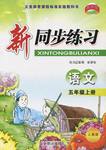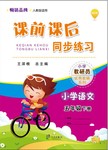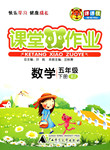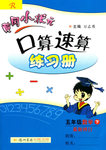
短文改错
假定英语课上老师要求同桌之间交换修改作文,请你修改你同桌写的以下作文。文中共有10处语言错误,每句中最多有两处。每处错误仅涉及一个单词的增加、删除或修改。
增加:在缺词处加一个漏词符号(∧),并在其下面写出该加的词。
删除:把多余的词用斜线(﹨)划掉。
修改:在错的词下划一横线,并在该词下面写出修改后的词。
注意:1.每处错误及其修改均仅限一词;
2.只允许修改10处,多者(从第11处起)不计分。
Dear Mandy,
I'm not doing well in my lessons at school,especial in maths. My dad says I must try hard because he wants me go to university. He thinks I'm lazy,but it's not true. I work really hard,often study late into the night! I've tried to talk to my mother,but she always said I have to work as hard like my brother does. My brother doesn't study very hard,and he always gets excellent grades. It's not fair!
The only thing I like it is art. My teacher says I'm the best student she's had for year. When I told my dad,all he said was,“ You mustn’t waste your time in art. You must focus your mind on your lessons! ”
I'm feeling quite puzzling as to what to do now. Would you please help me out?
Thanks a lot!
Yours sincerely, Lisa
 教学练新同步练习系列答案
教学练新同步练习系列答案 课前课后同步练习系列答案
课前课后同步练习系列答案 课堂小作业系列答案
课堂小作业系列答案 黄冈小状元口算速算练习册系列答案
黄冈小状元口算速算练习册系列答案 成功训练计划系列答案
成功训练计划系列答案科目:高中英语 来源:2015-2016学年浙江杭州二中高二上学期期末英语试卷(解析版) 题型:单项填空
The watchdog will allow residents to smoke meat in an enclosed environment without polluting the air. __________ at in this way, the future situation doesn’t seem so disappointing.
A. Looking B. Looked C. Having looked D. To look
查看答案和解析>>
科目:高中英语 来源:2016届江苏省高三下学期周练英语试卷(解析版) 题型:单项填空
In fighting with enemies, the economy dropped greatly, ______, many lives were claimed.
A. on top of that B. in contrast
C. for another thing D. above all
查看答案和解析>>
科目:高中英语 来源:2016届江苏省高三下学期周练英语试卷(解析版) 题型:单项填空
Our mothers sat us down to read and paint, ____ all we really wanted to do was to make a mess.
A. since B. as C. unless D. when
查看答案和解析>>
科目:高中英语 来源:2016届安徽省“江南十校”高三3月联考英语试卷(解析版) 题型:阅读理解
The federal school lunch program for 30 million low-income children was created more than half a century ago to combat malnutrition(营养不良). A breakfast program was added during the 1960s, and both attempted to improve the nutritional value of food served at school.
More must be done to fight the childhood obesity(肥胖) epidemic, which has caused a frightening peak in weight-related disorders like diabetes, high-blood pressure and heart disease among young people. The place to start is schools, where junk food sold outside the federal meals program—through snack bars and vending machines—has pretty much canceled out the benefits of all those efforts.
Federal rules that govern the sales of these harmful foods at school are limited and have not been updated for nearly 40 years. Until new regulations are written, children who are served healthy meals in the school cafeteria will continue to buy candy drinks and high sodium(钠) snacks elsewhere in school.
Many states’ school districts have taken positive steps, but others are likely to resist, especially districts that sell junk food to finance athletic program extracurricular activities, and even copier expenses.
Those districts should take note of a study released in 2009 in West Virginia showing that the budgetary costs of switching from sodas to healthy drinks such as fruit juice, milk, and water were very little. Even if the switch costs money, so be it. The school should not be trading their students’ health to buy office supplies.
Over the last five decades, the obesity rates for adolescents have tripled. Unless there is decisive action, weight and inactivity-related disorders will bother a steady larger proportion of the work force and replace smoking as the leading cause of premature death.
1.According to this passage, ______ are to blame for the childhood obesity.
A. weight-related disorders
B. high calorie snacks
C. parents’ bad habits
D. unhealthy lunches and breakfast
2.Which is the main idea of Paragraph 3?
A. Federal governments deserve high praise for their school lunch program.
B. New regulations are badly in need of updating.
C. Children should be forbidden to buy snacks in school.
D. Federal rules encourage snacks outside the school program.
3.The passage is concerned mainly with ______.
A. Malnutrition in low-income children
B. The federal school lunch program
C. obesity at school
D. the nutritional value of food served at school
4.The tone of this passage is ______.
A. negative B. indifferent
C. optimistic D. ironic
查看答案和解析>>
科目:高中英语 来源:2015-2016学年山西怀仁一中高二下学期一次月考英语试卷(解析版) 题型:阅读理解
People who are worried about bad breath often reach for a toothbrush or a gun. But in the future, personal breath monitoring may include far more than fresh breath.
In face, breath is so rich in chemical compounds that fully understanding it has proved challenging. Each breath contains gases like carbon dioxide, the volatile(挥发性的)remains of recent snacks, medicines and even compounds taken in from things like carpeting or various kinds of air pollution. But breath detectors(检测器) can sort out these substances with increasing sensitivity(敏感性)。
Scientists are building electronic sniffers that examine the exhaled(呼气)air for signs of cancer, asthma(哮喘), and other diseases.
“There are clear signatures in the breath for liver(肝)disease, kidney(肾)disease and heart disease. Breath is a rich mixture that can reflect out state of health and disease.” said Dr. Raed Dweik, director of the Cleveland Clinic, adding “Breath analysis is the future of medical testing.”
He and his partners are testing a desktop system called BreathLink for use in rapid identification of diseases. The system is designed to work wherever there is an Internet connection. To use BreathLink, a person breathes into a long tube, and a breath sample is collected and analyzed within the system. Then it can detail chemical concentrations(浓度)of the breath in graphics. Dr. Raed Dweik said, “If you examine patients of asthma, you will find they have higher levels of nitric oxide(一氧化碳) in their exhaled air. It reflects their abnormal symptoms in the lungs.” His tests have reached 85 percent accuracy(精确度)so far in spotting people with some illness.
But some trained dogs, he pointed out, can sniff out cancer with 99 percent accuracy—although without the ability to identify particular compounds the way some detectors can.
“We are getting better and better,” he said. “But whether we will ever approach the accuracy of the dog—we don’t know.”
1.What is the breath detector used for?
A. To find what kind of disease a person has.
B. To identify substances from people’s breath.
C. To help a patient recover from disease.
D. To smell how bad the breath is.
2.In the fifth paragraph, what Dr. Raed Dwik said is meant to______.
A. show how he and his partners treated patients
B. tell why a person has asthma
C. show how sensitive the device is
D. show how to diagnose a patient of asthma
3.It can be inferred that_______
A. brushing teeth can improve one’s bad breath
B. there are leftovers like snacks and medicines in one’s breath
C. one can know exactly about his physical state through the breath
D. breath analysis can be helpful in medical diagnosis
4.What’s the author’s attitude towards the future of breath detectors?
A. Indifferent B. Positive
C. Doubtful. D. Critical.
查看答案和解析>>
科目:高中英语 来源:2015-2016学年四川绵阳南山中学高二3月入学考试英语卷(解析版) 题型:阅读理解
In its early history, Chicago had floods frequently, especially in the spring, making the streets so muddy that people, horses, and carts got stuck. An old joke that was popular at the time went something like this: A man is stuck up to his waist in a muddy Chicago street. Asked if he needs help, he replies,“No, thanks. I’ve got a good horse under me.”
The city planners decided to build an underground drainage(排水) system, but there simply wasn’t enough difference between the height of the ground level and the water level. The only two options were to lower the Chicago River or raise the city.
An engineer named Ellis Chesbrough convinced the city that it had no choice but to build the pipes above ground and then cover them with dirt. This raised the level of the city’s streets by as much as 12 feet.
This of course created a new problem: dirt practically buried the first floors of every building in Chicago. Building owners were faced with a choice: either change the first floors of their buildings into basements, and the second stories into main floors, or hoist the entire bulidings to meet the new street level. Small wood-frame buildings could be lifted fairly easily. But what about large, heavy structures like the Tremont Hotel, which was a six-story brick building?
That’s where George Pullman came in. He had developed some house-moving skills successfully. To lift a big structure like Tremont Hotel, Pullman would place thousands of jackscrews(螺旋千斤顶) beneath the building’s foundation. One man was assigned to operate each section of roughly 10 jackscrews. At Pullman’s signal each man turned his jackscrew the same amount at the same time, thereby raising the building slowly and evenly. Astonishingly, the Tremont Hotel stayed open during the entire operation, and many of its guests didn’t even notice anything was happening.
Some people like to say that every problem has a solution. But in Chicago’s early history, every engineering solution seemed to create a new problem. Now that Chicago’s waste water was draining efficiently into the Chicago River, the city’s next step was to clean the polluted river.
1.The author mentions the joke to show_________.
A. horses were fairly useful in Chicago
B. Chicago’ streets were extremely muddy
C. Chicago was very dangerous in the spring
D. the Chicago people were particularly humorous
2.The city planners were convinced by Elllis Chesbrough to__________.
A. get rid of the street dirt
B. lower the Chicago River
C. fight against heavy floods
D. build the pipes above ground
3.The underlined word”hoist”in Paragraph 4 means ___________
A. change B. lift C. repair D. decorate
4.What can we conclude about the moving operation of the Tremont Hotel?
A. It went on smoothly as intended.
B. It interrupted the business of the hotel.
C. It involved Pullman turning ten jackscrews.
D. It separated the bulding from its foundation.
5.The passage is mainly about early Chicago’s _________
A. popular life styles and their influences
B. environmental disasters and their causes
C. engineering problems and their solutions
D. successful businessmen and their achievements
查看答案和解析>>
科目:高中英语 来源:2016届宁夏长庆高级中学高三下学期第一次模拟考试英语试卷(解析版) 题型:阅读理解
D Throughout the history of the arts, the nature of creativity has remained constant to artists.No matter what objects they select, artists are to bring forth new forces and forms that cause change---to find poetry where no one has ever seen or experienced it before.
Landscape (风景) is another unchanging element of art.It can be found from ancient times through the17th-century Dutch painters to the 19th-century romanticists and impressionists.In the 1970s Alfred Leslie, one of the new American realists, continued this practice.Leslie sought out the same place where ThomasCole, a romanticist, had produced paintings of the same scene a century and a half before.Unlike Cole who insists on a feeling of loneliness and the idea of finding peace in nature, Leslie paints what he actually sees.In his paintings, there is no particular change in emotion, and he includes ordinary things like the highway in the background.He also takes advantage of the latest developments of color photography to help both the eye and the memory when he improves his painting back in his workroom.
Besides, all art begs the age-old question: What is real? Each generation of artists has shown their understanding of reality in one form or another.The impressionists saw reality in brief emotional effects, the realists in everyday subjects and in forest scenes, and the Cro-Magnon cave people in their naturalistic drawings of the animals in the ancient forests.To sum up, understanding reality is a necessary struggle for artists of all periods.
Over thousands of years the function of the arts has remained relatively constant.Past or present, Eastern or Western, the arts are a basic part of our immediate experience.Many and different are the faces ofart, and together they express the basic need and hope of human beings.
1.The underlined word “poetry” most probably means ________ .
A.an object for artistic creation
B.an unusual quality
C.a collection of poems
D.a natural scene
2.Leslie’s paintings are extraordinary because ___________.
A.they draw attention to common things in life
B.they look like works by 19th-century painters
C.they are close in style to works in ancient times
D.they depend heavily on color photography
3.What is the author’s opinion of artistic reality?
A.It does not have a long-lasting standard
B.It will not be found in future works of art.
C.It is expressed in a fixed artistic form.
D.It is lacking in modern works of art.
4.Which of the following is the main topic of the passage?
A.History of the arts.
B.Use of modern technology in the arts.
C.Basic questions of the arts.
D.New developments in the arts.
查看答案和解析>>
科目:高中英语 来源:2016届湖北省黄冈市高考英语阅读理解专项精练(解析版) 题型:阅读理解
阅读理解-。阅读下列四篇短文,从每小题后所给的A,B,C或D四个选项中,选出最佳选项。
Many people believe Henry Ford invented the automobile (汽车).But Henry Ford did not start to build his first car until 1896.That was eleven years after two Germans developed the world's first automobile.Many people believe Henry Ford invented the production line that moved a car's parts to the worker,instead of making the worker move to the parts.That is not true,either.Many factory owners used methods of this kind before Ford.What Henry Ford did was to use other people's ideas and make them better.And he made the whole factory a moving production line.
In the early days of the automobile,almost every car maker raced his cars.It was the best way of gaining public notice.Henry Ford decided to build a racing car.Ford's most famous race was his first one.It was also the last race in which he drove the car himself.
The race was in 1901,at a field near Detroit.All of the most famous cars had entered, but only two were left:the Winton and Ford's.The Winton was famous for its speed.Most people thought the race was over before it began.
The Winton took an early lead.But halfway through the race, it began to lose power.Ford started to gain.And near the end of the race, he took the lead.Ford won the race and defeated the Winton.His name appeared in newspapers and he became well?known all over the United States.Within weeks of the race, Henry Ford formed a new automobile company.In 1903, a doctor in Detroit bought the first car from the company.That_sale was the beginning of Henry Ford's dream.Ford said: “I will build a motor car for the great mass of people.It will be large enough for the family, but small enough for one person to operate and care for.It will be built of the best materials.It will be built by the best men to be employed.And it will be built with the simplest plans that modern engineering can produce.It will be so low in price that no man making good money will be unable to own one.”
The Model T was a car of that kind.It only cost $850.It was a simple machine that drivers could depend on.Doctors bought the Model T.So did farmers.Even criminals. They considered it the fastest and surest form of transportation.Americans loved the Model T.They wrote stories and songs about it.Thousands of Model T's were built in the first few years.
1.What do we know about Henry Ford from Paragraph 1?
A.He made good use of ideas from others.
B.He produced the first car in the world.
C.He knew how to improve auto parts.
D.He invented the production line.
2.Why did Henry Ford take part in the 1901 car race?
A.To show off his driving skills. B.To draw public attention.
C.To learn about new technology. D.To raise money for his new company.
3.“That sale” in Paragraph 4 refers to______.
A.the selling of Ford cars at reduced prices
B.the sale of Model T to the mass of people
C.the selling of a car to a Detroit doctor
D.the sales target for the Ford Company
4.What was Henry Ford's dream according to the text?
A.Producing cars for average customers.
B.Building racing cars of simple design.
C.Designing more car models.
D.Starting more companies.
查看答案和解析>>
湖北省互联网违法和不良信息举报平台 | 网上有害信息举报专区 | 电信诈骗举报专区 | 涉历史虚无主义有害信息举报专区 | 涉企侵权举报专区
违法和不良信息举报电话:027-86699610 举报邮箱:58377363@163.com